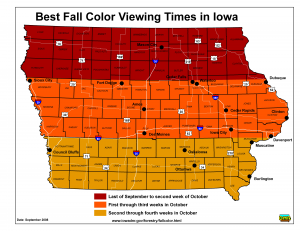Fall Color Facts
By Taylor on October 11, 2013 in Blog
In the next few weeks, trees should start speckling the Iowa landscape with autumn color.
“Peak fall color occurs in northeast Iowa, on average, on the weekend closest to October 10. Peak fall colors occur later in the more southern parts of the state.” according to the Iowa Department of Natural Resources.

Image from Iowa Department of Natural Resources
Each year the fall foliage is a bit different than the previous year.
Seasonal changes in weather and the quantity of daylight combined with soil acidity, tree species and location determine which hues will appear.
As days get shorter, plants produce less chlorophyll, and the green color begins to fade. This allows other pigments in the leaves to show through. Less sunlight can also lead to a buildup of sap in leaves and the formation of other pigments, causing leaves to turn purple or red depending on the acidity of the sap.
Temperature also influences the leaves' colors. It affects the rate that chlorophyll is destroyed and impacts the shades and vibrancy. Freezing temperatures are not conducive to producing red pigments. Frosts destroy leaf cells and can interrupt the coloration process altogether.
For more information about when and why leaves change color this time of year, visit the Iowa DNR website.
You can also get weekly updates for fall conditions in Iowa at the website or by calling (515) 233-4110.
Information from this post was gathered from the Iowa Department of Natural Resources, Forestry Bureau website.